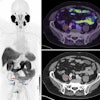
A 3D image fusion technique that combines CT and MRI data shows promise for helping clinicians better diagnose coronary artery disease, according to a study published on 16 April in Radiology: Cardiothoracic Imaging.
The results could allow doctors to quickly resolve inconsistent findings between the two modalities, wrote a team led by Dr. Jochen von Spiczak of University Hospital Zurich in Switzerland.
"[Conventional cardiac CT and MRI] led to a substantial number of uncertain findings in our study ... [and] most of these divergent findings could be solved when including additional information from CT-derived blood flow estimates information and 3D image fusion," von Spiczak said in a statement released by the RSNA.
CT and MRI have long been used for cardiac imaging and evaluation of coronary artery disease, the researchers wrote. CT produces high-resolution images of the heart's anatomy, and cardiac MRI offers information on blood supply to the heart muscle. But the two exams are conducted and read separately. In an effort to overcome uncertain findings and cut interpretation time, von Spiczak and colleagues developed multimodality 3D image fusion software that can fuse data from CT and MRI into 3D images.
To test the software, von Spiczak performed a research study that included 17 patients who underwent cardiac CT and cardiac MRI between May 2009 and January 2016 due to suspected coronary artery disease. The team compared conventional cardiac CT and MRI reports with the 3D fusion software images, rating image quality on a scoring system of 0 to 3 (0 = insufficient, 1 = moderate, 2 = good, and 3 = excellent).
CT coronary angiography showed stenoses in seven cases (41%), while cardiac MRI perfusion showed hypoperfusion in eight patients (47%). Conventional 2D reports from these exams resulted in eight of 17 cases with uncertain findings. But 75% of these uncertain findings were resolved by the 3D fusion images.
The quality of the 3D images was rated good to excellent (mean score, 2.6), and interpretation correlation among the radiologist readers between the conventional CT and MRI reports and the 3D images was 94%.
"The strength of this approach is the ability to incorporate all the information from both imaging modalities to obtain a comprehensive understanding of the coronary anatomy, myocardial perfusion, and scar burden," the authors wrote.
The team acknowledged that the number of patients who undergo both cardiac CT and MRI is low. But using both MRI and CT plus 3D fusion could be beneficial when the initial MR imaging results in uncertain findings.
"A two-stage diagnostic procedure including CT and cardiac MRI yields diagnostic advantages but is also associated with higher costs and complexity," von Spiczak and colleagues concluded. "Therefore, such diagnostic workup should be reserved for complex pathologic cases with uncertain findings in the first test. Complicated cases may particularly benefit from the insights gained by 3D image fusion. ... In this way, a two-step diagnostic approach combined with ... 3D image fusion might serve as a gatekeeper for coronary angiography, coronary interventions, and surgery."



















